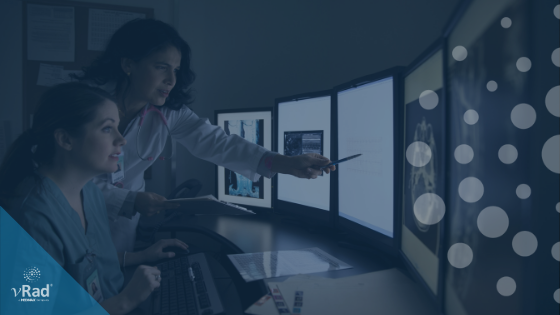Why Radiologists Are Essential to AI Imaging
For the latest information on vRad’s Artificial Intelligence program please visit vrad.com/radiology-services/radiology-ai/ Early hype implied that...

Remote radiologist jobs with flexible schedules, equitable pay, and the most advanced reading platform. Discover teleradiology at vRad.

Radiologist well-being matters. Explore how vRad takes action to prevent burnout with expert-led, confidential support through our partnership with VITAL WorkLife. Helping radiologists thrive.

Visit the vRad Blog for radiologist experiences at vRad, career resources, and more.

vRad provides radiology residents and fellows free radiology education resources for ABR boards, noon lectures, and CME.

Teleradiology services leader since 2001. See how vRad AI is helping deliver faster, higher-quality care for 50,000+ critical patients each year.

Subspecialist care for the women in your community. 48-hour screenings. 1-hour diagnostics. Comprehensive compliance and inspection support.

vRad’s stroke protocol auto-assigns stroke cases to the top of all available radiologists’ worklists, with requirements to be read next.

vRad’s unique teleradiology workflow for trauma studies delivers consistently fast turnaround times—even during periods of high volume.

vRad’s Operations Center is the central hub that ensures imaging studies and communications are handled efficiently and swiftly.

vRad is delivering faster radiology turnaround times for 40,000+ critical patients annually, using four unique strategies, including AI.
.jpg?width=1024&height=576&name=vRad-High-Quality-Patient-Care-1024x576%20(1).jpg)
vRad is developing and using AI to improve radiology quality assurance and reduce medical malpractice risk.

Now you can power your practice with the same fully integrated technology and support ecosystem we use. The vRad Platform.

Since developing and launching our first model in 2015, vRad has been at the forefront of AI in radiology.

Since 2010, vRad Radiology Education has provided high-quality radiology CME. Open to all radiologists, these 15-minute online modules are a convenient way to stay up to date on practical radiology topics.

Join vRad’s annual spring CME conference featuring top speakers and practical radiology topics.

vRad provides radiology residents and fellows free radiology education resources for ABR boards, noon lectures, and CME.

Academically oriented radiologists love practicing at vRad too. Check out the research published by vRad radiologists and team members.

Learn how vRad revolutionized radiology and has been at the forefront of innovation since 2001.

%20(2).jpg?width=1008&height=755&name=Copy%20of%20Mega%20Nav%20Images%202025%20(1008%20x%20755%20px)%20(2).jpg)

Visit the vRad blog for radiologist experiences at vRad, career resources, and more.


Explore our practice’s reading platform, breast imaging program, AI, and more. Plus, hear from vRad radiologists about what it’s like to practice at vRad.

Ready to be part of something meaningful? Explore team member careers at vRad.
5 min read
 John Musick
:
December 8, 2023
John Musick
:
December 8, 2023
-3.png)
How well does your workstation and platform meet your needs to work efficiently, effectively, and without frustration?
In my five years working with radiologists as a trainer on the vRad platform, I observed a wide range of needs and backgrounds. This experience highlighted a critical, yet often overlooked, aspect in our field: the need for accessible workstations tailored for radiologists with disabilities or other physical limitations. This includes radiologists with pre-existing accessibility needs, those who experience an unexpected health event, and those who may develop long-term issues such as a repetitive motion disorder.
Given the current physician shortage and the fact that more than half of all practicing radiologists are over the age of 55, addressing accessibility is especially urgent. Practices cannot afford to leave any stones unturned when it comes to radiologist efficiency and creating a great work environment that will attract radiologists and retain them by keeping them professionally satisfied throughout their tenure.
Ergonomic designs and adaptive technologies exist today that are paving the way for more inclusive environments, ensuring that disabilities do not hinder a successful career in this vital field. I recently worked with a radiologist whose arthritis had gotten so bad he feared he would have to stop working altogether. After making a few modifications to his workstation, we were able to alleviate the pain and extend his otherwise highly successful career.
Let’s delve into how we make this possible.
Creating an accessible environment involves both the physical and cognitive aspects of ergonomics.
Physical ergonomics involves examining the physical activity of reading studies to make it as easy and comfortable as possible. It aims to reduce the likelihood of repetitive stress injuries and accommodate those who may have mobility issues or other physical limitations.
Between operating a computer mouse and holding a Dictaphone, radiologists’ hands are always busy and extremely important to their work. To address hand mobility limitations or weakness, we have had good results deploying alternative technical solutions not typically found in radiology.
This issue is doubly important for our radiologists. Having eliminated Dictaphones over a decade ago in favor of 100% voice recognition, they now control input devices with both hands. While the right hand scrolls through images, the left manipulates image views, changes windows, advances series, and other reading functions using “hotkeys” on a multi-button input device called the vGrip.
.png?width=382&height=382&name=Board%20Review%20Prizes%20(4).png)
One radiologist I worked with was on the verge of retirement due to arthritis that had developed in his thumb leaving him with virtually no mobility. To solve for this, we sourced a large-button audiovisual device called the Stream Deck that didn’t require the use of his thumb and programmed it with his favorite vGrip hotkeys. This allowed him to continue using his left hand, even with the very limited use of his thumb.
Another radiologist on our team with quadriplegia was unable to use the vGrip because he could not press the buttons when his hand was cupped to the shape of the device. We solved this challenge with the Shuttle Pro, a low-contour input device which allows him to use his preferred shortcut commands with his hand lying flat. We also set him up with voice commands and special protocols that were better adapted to his abilities.
Voice recognition was undoubtedly a major advancement in terms of efficiency for radiology. However, some voices are more difficult for the software to understand—due to a strong accent for example—which can reduce the accuracy of the dictation. With a little extra effort by the trainers or IT department, the voice recognition software can often be fine-tuned to address the issue.
For instance, the software was failing to recognize some words being dictated by a radiologist on our team who is deaf. We were able to customize the system to recognize his pronunciation of these words, ensuring the correct terms were included in the report. This adjustment significantly reduced his frustration and improved his work efficiency.
One benefit of a remote reading environment is the ability to use different types of workstations that might better suit your comfort. We commonly see radiologists switch their workstation to standing desks, or treadmill desks to avoid sitting for long periods of time.
A unique example of creating a truly adaptive workstation was for a radiologist who, following a surgery, was not going to be able to sit or stand for long periods for the foreseeable future. To continue working, she installed an anti-gravity chair in her home office, completely customizing her workstation to be fully accessible, and comfortable. This enabled her to keep practicing instead of retiring early.
Cognitive ergonomics prompts us to consider the mental bandwidth required to navigate the information stream and whether the platform or environment needs modification to ensure radiologists don’t become overwhelmed. Research has shown that high levels of cognitive load (diagnosing, decision-making, distractions, interruptions, multitasking, etc.) are associated with impaired function and higher burnout risk among physicians.
As designers of radiologist work environments, or trainers on the tools they use, there are many things we can do to reduce cognitive load and minimize its negative effects. And oftentimes these improvements can also be helpful for someone with a physical disability or limitation. Here are just a few examples:
Are there changes you can make to the physical workspace that will reduce distractions? Teleradiology is inherently great for avoiding the distractions of a busy hospital, but even radiologists working remotely should evaluate their home reading environments.
Are there ways to reduce the need for multitasking? We extensively use voice recognition macros and natural language processing for our reports. Not only does this keep the radiologist’s eyes on the images but avoids the cognitive shift that takes place when trying to manually review and edit a report while working through their search pattern.
Inefficiency is a drain on a radiologist’s cognitive capacity. Look for way to reduce unnecessary or repetitive steps. Technologies that are currently in use may have time-saving features that are underutilized—needing just some refresher training.
Our adoption of macro-driven reporting was a quantum leap in terms of radiologist efficiency. But smaller improvements have reduced work effort as well. For example, almost every button and tab on our reading platform can be initiated through a voice command. You can also manipulate images and call out different window-level presets through voice commands. This feature is especially appreciated by the radiologists with hand mobility limitations.
For more actionable ideas and information on the concepts of doctoring as cognitive labor, cognitive load theory, and cognitive ergonomics, I recommend checking out a very interesting article published in August 2023: Cognitive Ergonomics: A Review of Interventions for Outpatient Practice.
It’s important for imaging providers to have mechanisms in place that will allow a radiologist with a disability or limitation to communicate their needs and have them addressed. This should be built into the organization's culture, not bolted on as an afterthought.
I suggest working closely with your radiologists from day one to ensure they can work comfortably and efficiently.
This open line of communication should continue after a personalized onboarding and in-depth training through periodic follow-ups so there is a constant feedback loop where questions, concerns, and challenges can be addressed. If a refresher on something technical, a custom adjustment to software, or an alternative mouse is needed; we have it covered.
These tailored solutions have greatly reduced stress and effort for our radiologists. We hope to build on our current capabilities, leveraging voice command technology to anticipate the future needs of radiologists with disabilities. Our plan is to create a suite of the most advantageous commands and offer these as a complete package when we onboard people.
There was once a time when health challenges or technological limitations could cut a radiologist’s career short or stop it before it ever got started. We’re working to change that.
Back to Blog
For the latest information on vRad’s Artificial Intelligence program please visit vrad.com/radiology-services/radiology-ai/ Early hype implied that...

If your Curriculum Vitae isn’t all it could be, you may as well be stacking trophies in a cave. I say this as a longtime radiologist recruiter who...
.png)
Radiologists reading on home workstations have become a permanent feature of the post-COVID modern medical landscape. Whether every day or just one...
vRad (Virtual Radiologic) is a national radiology practice combining clinical excellence with cutting-edge technology development. Each year, we bring exceptional radiology care to millions of patients and empower healthcare providers with technology-driven solutions.
Non-Clinical Inquiries (Total Free):
800.737.0610
Outside U.S.:
011.1.952.595.1111
3600 Minnesota Drive, Suite 800
Edina, MN 55435